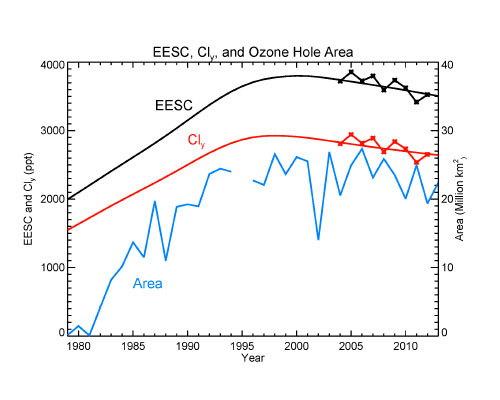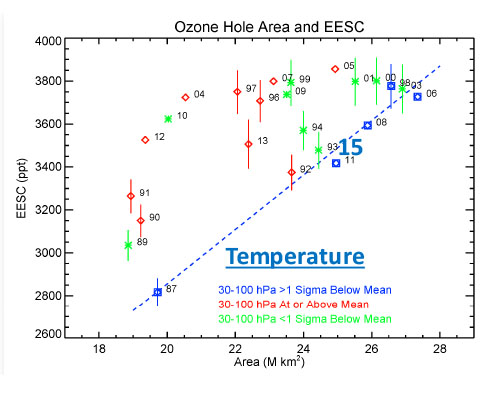Ozone-depleting chemicals in the atmosphere cause an ozone hole to form over Antarctica during the winter months in the Southern Hemisphere. Since the Montreal Protocol agreement in 1987, emissions have been regulated and chemical levels have been declining. However, the ozone hole has still remained bigger than 8 million square miles since the early 1990s, with exact sizes varying from year to year.
The size of the ozone hole varies due to both temperature and levels of ozone-depleting chemicals in the atmosphere. In order to get a more accurate picture of the future size of the ozone hole, scientists used NASA's AURA satellite to determine how much the levels of these chemicals in the atmosphere varied each year. With this new knowledge, scientists can confidently say that the ozone hole will be consistently smaller than 8 million square miles by the year 2040. Scientists will continue to use satellites to monitor the recovery of the ozone hole and they hope to see its full recovery before the end of the century.

The size of the Ozone Hole (blue) grew rapidly in the 1980s when chlorine (or EESC) was rapidly increasing (black and red). In the 1990s the growth ceased. Although they have slowly declined since 2000, chlorine (Cly) and EESC remain relatively high and the hole areas have been >20 million km2 nearly every year. The hole size is primarily affected by lower stratospheric vortex temperatures, so it is difficult to disentangle the effect of the slowly declining Cly on area.
EESC is Equivalent Effective Stratospheric Chlorine. It is Cly + 60*Bry. Bry is estimated from surface source gases. Ozone hole area is calculated from NASA satellite measurements of total column O3 <220 DU in late September.

There is a positive correlation between hole area and EESC but with much scatter. When we consider only the coldest Septembers in the Antarctic lower stratosphere (blue points), a linear relationship emerges between area and EESC.
The relationship during cold years shows that EESC must decline below 1987 levels for ozone holes to be consistently smaller than their current large size of >20 million km2.
Aura Microwave Limb Sounder (MLS) N2O data was used to infer chlorine (and EESC) levels inside the ozone hole. For years prior to Aura, EESC was estimated from surface source gas abundances and an assumed 5.2 year mean age for the Antarctic lower stratosphere. This figure has been updated with 2015 data, an extremely cold year. The 2015 point falls on the line.

Relevance for Future Science:
Microwave Limb Sounder (MLS) N2O measurements provide crucial information that allows us to infer inorganic chlorine levels inside the Antarctic ozone hole during the period of ozone depletion (Aug & Sep). This information make possible the attribution of O3 changes to the impact of the Montreal Protocol - no other satellite instrument provides comparable dynamical information.
Data Sources: Aura Microwave Limb Sounder N2O version 4. Ozone hole area data were obtained from the NASA Ozone Watch website.
References: Strahan, S.E., A.R. Douglass, P.A. Newman, and S.D. Steenrod (2014), Inorganic chlorine variability in the Antarctic vortex and implications for ozone recovery, J. Geophys. Res., 119, doi:1002/2014JD022295.
1.31.2017